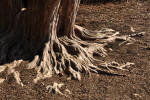 Shallow roots on trees can lead to two major problems in
the home landscape. First, if they are planted near
sidewalks or driveways, over decades, they can
eventually lift these features out of the ground. Also,
roots can emerge from the ground and make mowing
grass over them hazardous.
Shallow roots on trees can lead to two major problems in
the home landscape. First, if they are planted near
sidewalks or driveways, over decades, they can
eventually lift these features out of the ground. Also,
roots can emerge from the ground and make mowing
grass over them hazardous.
From the tree's
standpoint, shallow roots make it more difficult for
them to thrive in the typical landscape site. Such roots
are more susceptible to the negative effects of soil
compaction. As the soil gets harder due to foot or
equipment traffic or just because it has a high
clay
content, the tree finds it difficult to expand its root
system. When this happens, the tree is liable to suffer
what is called "shade
tree decline" which is a nebulous term that means
that the plant is just not happy with its site anymore.
Here are some common
landscape trees that have shallow root systems:



